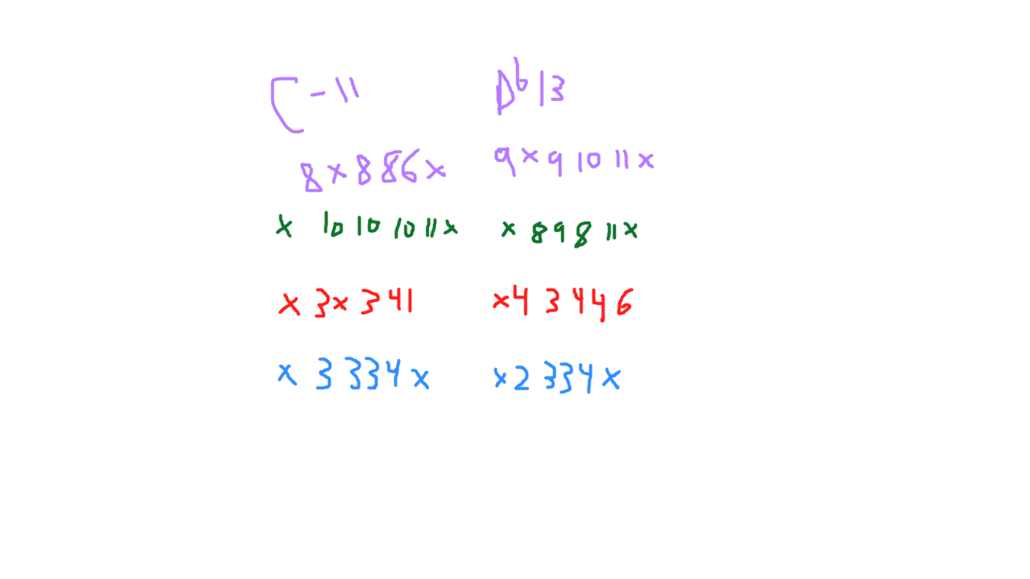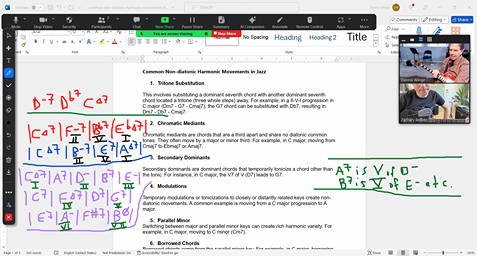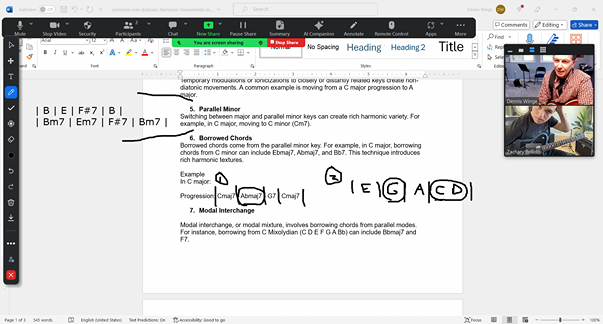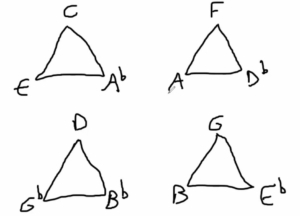Common Non-diatonic Harmonic Movements in Jazz
- Tritone Substitution
This involves substituting a dominant seventh chord with another dominant seventh chord located a tritone (three whole steps) away. For example, in a II-V-I progression in C major (Dm7 – G7 – Cmaj7), the G7 chord can be substituted with Db7, resulting in Dm7 – Db7 – Cmaj7.
- Chromatic Mediants
Chromatic mediants are chords that are a third apart and share no diatonic common tones. They often move by a major or minor third. For example, in C major, moving from Cmaj7 to Ebmaj7 or Amaj7.
- Secondary Dominants
Secondary dominants are dominant chords that temporarily tonicize a chord other than the tonic. For instance, in C major, the V7 of V (D7) leads to G7.
- Modulations
Temporary modulations or tonicizations to closely or distantly related keys create non-diatonic movements. A common example is moving from a C major progression to A major.
- Parallel Minor
Switching between major and parallel minor keys can create rich harmonic variety. For example, in C major, moving to C minor (Cm7).
- Borrowed Chords
Borrowed chords come from the parallel minor key. For example, in C major, borrowing chords from C minor can include Ebmaj7, Abmaj7, and Bb7. This technique introduces rich harmonic textures. Example in C major: | Cmaj7 | Abmaj7 | G7 | Cmaj7 |
- Modal Interchange
Modal interchange, or modal mixture, involves borrowing chords from parallel modes. For instance, borrowing from C Mixolydian (C D E F G A Bb) can include Bbmaj7 and F7. Example in C major: | Cmaj7 | Bbmaj7 | F7 | Cmaj7 |
- Augmented Sixth Chords
These chords, often used in classical music, also appear in jazz to lead into the dominant chord. The German augmented sixth (e.g., Ab-C-Eb-F# in C major) resolves to the G7 chord. Example in C major: Ab7 – G7 – Cmaj7
- Neapolitan Chord
The Neapolitan chord (bII) is a major chord built on the flattened second degree of the scale. It typically appears in first inversion to lead into the dominant chord. Example in C major: | Db/F | G7 | Cmaj7 |
- Extended Dominant Chains
Extended dominant chains involve a series of dominant chords resolving by descending fifths, often leading to a final resolution. Example in C major: | E7 A7 | D7 G7 | Cmaj7 |
- Chromatic Passing Chords
Chromatic passing chords fill the gap between diatonic chords, creating smooth voice leading and harmonic interest. Example in C major: | Cmaj7 B7 | Bb7 A7 | Dm7 G7 | Cmaj7 |
- Altered Dominant Chords
Altered dominants feature alterations (e.g., b5, #5, b9, #9) to add tension before resolving to the tonic. Example in C major: | G7#5 | Cmaj7 |
- Coltrane Changes
Popularized by John Coltrane, these progressions move through keys by major thirds. In “Giant Steps,” the progression modulates between B, G, and Eb. Example
In B major: |Bmaj7 D7 | Gmaj7 Bb7 | Ebmaj7 F#7 | Bmaj7 |
Coltrane Changes
Giant Steps movement in 12 keys
Key of C: ||: Cmaj7 | Eb7 | Abmaj7 | B7 | Emaj7 | G7 :||
Key of Db: ||: Dbmaj7 | E7 | Amaj7 | C7 | Fmaj7 | Ab7 :||
Key of D: ||: Dmaj7 | F7 | Bbmaj7 | Db7 | Gbmaj7 | A7 :||
Key of Eb: ||: Ebmaj7 | Gb7 | Bmaj7 | D7 | Gmaj7 | Bb7 :||
Key of E: ||: Emaj7 | G7 | Cmaj7 | Eb7 | Abmaj7 | B7 :||
Key of F: ||: Fmaj7 | Ab7 | Dbmaj7 | E7 | Amaj7 | C7 :||
Key of Gb: ||: Gbmaj7 | A7 | Dmaj7 | F7 | Bbmaj7 | Db7 :||
Key of G: ||: Gmaj7 | Bb7 | Ebmaj7 | F#7 | Bmaj7 | D7 :||
Key of Ab: ||: Abmaj7 | B7 | Emaj7 | G7 | Cmaj7 | Eb7 :||
Key of A: ||: Amaj7 | C7 | Fmaj7 | Ab7 | Dbmaj7 | E7 :||
Key of Bb: ||: Bbmaj7 | Db7 | Gbmaj7 | A7 | Dmaj7 | F7 :||
Key of B: ||: Bmaj7 | D7 | Gmaj7 | Bb7 | Ebmaj7 | Gb7 :||
Coltrane Changes on Christmas Carols
https://guitarlessonsithaca.
4 places
https://guitarlessonsithaca.
3 places
https://guitarlessonsithaca.
3 places
https://guitarlessonsithaca.
3 places
https://guitarlessonsithaca.
2 places
https://guitarlessonsithaca.
2 places
https://guitarlessonsithaca.
1 place
https://guitarlessonsithaca.
1 place
https://guitarlessonsithaca.
1 place
https://guitarlessonsithaca.





